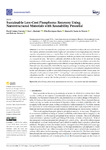Mostrar o rexistro simple do ítem
Sustainable Low-Cost Phosphorus Recovery Using Nanostructured Materials with Reusability Potential
| dc.contributor.author | Gómez-Carnota, David | |
| dc.contributor.author | Barriada, José Luis | |
| dc.contributor.author | Rodríguez-Barro, Pilar | |
| dc.contributor.author | Sastre de Vicente, Manuel | |
| dc.contributor.author | Herrero, Roberto | |
| dc.date.accessioned | 2023-07-05T18:27:56Z | |
| dc.date.available | 2023-07-05T18:27:56Z | |
| dc.date.issued | 2023-03-24 | |
| dc.identifier.citation | Gómez-Carnota, D.; Barriada, J.L.; Rodríguez-Barro, P.; Sastre de Vicente, M.E.; Herrero, R. Sustainable Low-Cost Phosphorus Recovery Using Nanostructured Materials with Reusability Potential. Nanomaterials 2023, 13, 1167. https://doi.org/10.3390/nano13071167 | es_ES |
| dc.identifier.issn | 2079-4991 | |
| dc.identifier.uri | http://hdl.handle.net/2183/33299 | |
| dc.description | This article belongs to the Topic Advances in Chemistry, XXVIth International Galician Portuguese Conference on Chemistry | es_ES |
| dc.description.abstract | [Abstract] A new low-cost material with a polymeric base formed from sodium silicate was developed. The material presents a nanostructured, highly rich iron surface with a large phosphorus retention capacity and potential reuse as a crop fertilizer. In the present study, we demonstrate that iron is the element that acts as an adsorbent for phosphate, while the polymeric base functions exclusively as a support for iron. The iron is uniformly adsorbed on the surface of the material, forming nanostructures, which ensure that iron works similarly to nanoparticles in solution but avoid other problems, such as particle agglomeration or the difficulty of separating them after the removal process. Materials were characterised by SEM, EDS, N2 sorption, and image processing, and the effect of pH, ionic strength, and temperature was studied. Sorption kinetics were analysed using Boyd’s diffusion model, and adsorption equilibria were studied using several adsorption models. A maximum iron adsorption on the polymeric base of 23.9 ± 0.3 mg Fe∙g−1 was found, while maximum phosphorus adsorption was 366 ± 21 mg P∙g−1 Fe. Thus, phosphorus is recovered from the aqueous medium with an inexpensive material that has the potential to be used directly as a fertilizer. | es_ES |
| dc.description.sponsorship | This research was funded by Agencia Estatal de Investigación (AEI) (Ministerio de Ciencia e Innovación) through research project PID2020-117910GB-C22 and by Xunta de Galicia through project ED431B 2022/40 | es_ES |
| dc.description.sponsorship | Xunta de Galicia; ED431B 2022/40 | es_ES |
| dc.language.iso | eng | es_ES |
| dc.publisher | MDPI | es_ES |
| dc.relation | info:eu-repo/grantAgreement/AEI/Plan Estatal de Investigación Científica y Técnica y de Innovación 2017-2020/PID2020-117910GB-C22/ES/CARACTERIZACION FISICO-QUIMICA DE LAS PROPIEDADES ACIDO-BASE DE LA MATERIA ORGANICA DISUELTA DESDE EL SUELO HASTA EL OCENAO/ | es_ES |
| dc.relation.uri | https://doi.org/10.3390/nano13071167 | es_ES |
| dc.rights | Atribución 4.0 Internacional | es_ES |
| dc.rights.uri | http://creativecommons.org/licenses/by/4.0/ | * |
| dc.subject | Phosphorus | es_ES |
| dc.subject | Adsorption | es_ES |
| dc.subject | Nanostructures | es_ES |
| dc.subject | Recovery | es_ES |
| dc.subject | Iron | es_ES |
| dc.subject | Environmental remediation | es_ES |
| dc.title | Sustainable Low-Cost Phosphorus Recovery Using Nanostructured Materials with Reusability Potential | es_ES |
| dc.type | info:eu-repo/semantics/article | es_ES |
| dc.rights.access | info:eu-repo/semantics/openAccess | es_ES |
| UDC.journalTitle | Nanomaterials | es_ES |
| UDC.volume | 13 (2023) | es_ES |
| UDC.issue | 7 | es_ES |
| UDC.startPage | 1167 | es_ES |
| dc.identifier.doi | 10.3390/nano13071167 |
Ficheiros no ítem
Este ítem aparece na(s) seguinte(s) colección(s)
-
GI-METMED - Artigos [11]






